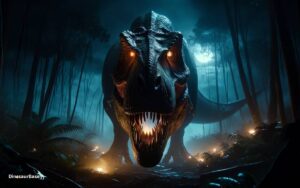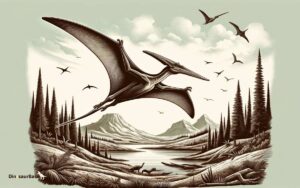Which Dinosaur Was the Smartest
Who hasn't pondered which dinosaur might have claimed the title of the smartest in its ancient realm?
The journey to uncover the prehistoric intellect champion takes us through a maze of brain-to-body ratios, cunning hunting strategies, and fossilized brain analyses.
While the Troodon, with its relatively large brain, often comes to the forefront, velociraptors shouldn't be underestimated for their tactical prowess.
Yet, the question lingers, does a larger brain necessarily equate to higher intelligence, or do we need to reevaluate our criteria?
The answer promises to reshape our understanding of these magnificent creatures, hinting at complexities that challenge our current perceptions.
Key Takeaways
- Troodon exhibited the highest indicators of intelligence among dinosaurs due to its exceptional brain-to-body ratio.
- Advanced cognitive abilities in dinosaurs are suggested by evidence of social behaviors and problem-solving skills.
- T-Rex also showed signs of sophisticated cerebral capacity, challenging previous underestimations of its intelligence.
- The study of dinosaur intelligence benefits from a multifaceted approach, including paleontological findings and comparative neuroanatomy.
Understanding Dinosaur Intelligence
Evaluating dinosaur intelligence necessitates a multifaceted approach, integrating paleontological findings and comparative neuroanatomy. Researchers delve into the ancient past, examining fossilized skulls to discern the size and structure of brain cavities. This investigation provides crucial insights into the neural capabilities of these prehistoric creatures.
Additionally, the study of contemporary descendants, such as birds and reptiles, offers valuable analogues, enabling scientists to make educated inferences about dinosaur cognition and behavior. Such comparative analyses shed light on potential sensory perceptions, social interactions, and problem-solving abilities.
Through meticulous examination and cross-species comparison, scholars strive to construct a coherent picture of dinosaur intelligence, navigating the complexities of evolutionary biology and neurology. This endeavor reflects a broader quest for understanding, emphasizing the intrinsic value of knowledge and the pursuit of intellectual emancipation.
The Significance of Brain-to-Body Ratio
In the quest to unravel dinosaur intelligence, the brain-to-body ratio emerges as a pivotal metric, offering profound insights into cognitive capacities. This ratio, a comparative measure, serves as an analytical tool to estimate the potential intelligence of dinosaurs. A higher ratio often indicates greater potential for complex behaviors and problem-solving abilities.
| Dinosaur | Estimated Brain Size (cm^3) | Estimated Body Mass (kg) |
|---|---|---|
| Tyrannosaurus | 500 | 9,000 |
| Velociraptor | 15 | 15 |
| Stegosaurus | 80 | 5,000 |
| Triceratops | 470 | 6,000 |
| Ankylosaurus | 250 | 6,000 |
This table illustrates the diversity in brain-to-body ratios across different dinosaur species, paving the way for nuanced discussions about their cognitive abilities and behavioral complexity.
Troodon: The Cerebral Champion?
The discussion of Troodon's intellectual prowess begins with an examination of its brain size, a critical factor that hints at its potential cognitive abilities.
Intelligence indicators, beyond mere cranial capacity, offer insights into the behavioral complexity and adaptability of this species.
A comparative analysis with contemporaneous dinosaurs further elucidates Troodon's standing as a possible cerebral champion, juxtaposing its neurological attributes against those of its peers.
Troodon Brain Size
Boasting one of the largest brain-to-body size ratios among dinosaurs, Troodon stands out as a cerebral champion, inviting thorough examination into its cognitive capabilities. This remarkable ratio suggests advanced neurological faculties, potentially indicative of complex behaviors not observed in many other dinosaur species. The significance of Troodon's brain size becomes even more compelling when considering the evolutionary implications.
- Relative Brain Size: Significantly larger compared to other theropods, hinting at advanced cognitive abilities.
- Encephalization Quotient (EQ): Troodon's EQ rivals that of modern birds, suggesting high intelligence.
- Neuroanatomy: Complex brain structure, possibly indicating sophisticated sensory perception.
- Comparative Analysis: When compared to other dinosaurs, Troodon's brain size suggests it may have been among the smartest.
This analysis underscores the unique position of Troodon in dinosaurian cognitive studies.
Intelligence Indicators
Exploring the intelligence indicators further, Troodon's exceptional brain-to-body size ratio and complex neuroanatomy offer compelling evidence of its cognitive sophistication among dinosaurs. This species, with its relatively large brain, suggests advanced sensory perception, problem-solving skills, and possibly even social behaviors that surpass those of its contemporaries.
Scholars argue that such cerebral capabilities imply a level of intelligence that would have facilitated complex hunting strategies, navigational skills, and perhaps even rudimentary forms of communication. The intricate structure of Troodon's brain, particularly the development of the cerebrum, points towards high-order processing abilities.
This, coupled with its keen vision and fine motor control as inferred from fossilized skeletons, positions Troodon at the forefront of dinosaurian intellectual capacity, challenging long-standing perceptions of dinosaur intelligence.
Comparative Analysis
In comparing Troodon's intellectual prowess with that of other dinosaurs, it emerges as a cerebral champion, showcasing a level of cognitive capability that significantly outstrips its prehistoric counterparts.
- *Troodon's brain-to-body size ratio was remarkably high, suggesting advanced neurological functions.*
- *This dinosaur possessed binocular vision, a trait indicative of a predator capable of calculating depth and distance with precision.*
- *Evidence points to complex social behaviors, further underscoring their sophisticated brainpower.*
- *Their dexterous hands may have been capable of manipulating objects, hinting at problem-solving skills.*
This comparative analysis, grounded in paleoneurological studies, underscores Troodon's exceptional standing in the Mesozoic cognitive hierarchy. It's clear that among the diverse tapestry of dinosaurian life, Troodon's intellect shines brightly, offering a fascinating glimpse into the evolutionary history of intelligence.
Velociraptors: Cunning Hunters
Velociraptors, renowned for their cunning hunting strategies, revolutionized our understanding of predatory behavior in the Cretaceous period. These small but formidable predators exhibited remarkable intelligence, often working in packs to outmaneuver their prey. This collaborative hunting strategy, akin to that of modern wolves, suggests a high level of social intelligence and communication among velociraptors.
Researchers have deduced their sophisticated tactics from fossilized remains that show evidence of coordinated attacks. The velociraptors' elongated skulls housed keen senses, particularly vision, which was crucial for identifying and stalking prey. Moreover, their forelimbs, equipped with large, recurved claws, were adapted for grasping, indicating a refined method of securing their targets.
This combination of physical and behavioral adaptations underscores their role as apex predators of their ecosystem, relying on their wit as much as their physical prowess.
The Enigmatic Intelligence of T-Rex
The Tyrannosaurus rex, often abbreviated as T-Rex, presents a fascinating case study in the exploration of dinosaur intelligence, particularly when examining its cranial capacity and predatory behaviors. Scholars argue that its brain size, relative to body mass, suggests a level of cognitive function that could have supported complex hunting strategies, surpassing mere brute strength.
Analyzing fossil evidence, researchers propose that T-Rex's sensory perceptions were highly developed, potentially facilitating sophisticated approaches to tracking and ambushing prey.
T-Rex Brain Size
Tyrannosaurus rex, often hailed as the apex predator of its time, possessed a brain size that suggests a level of intelligence possibly rivaling that of modern birds and mammals, sparking intense debate among paleontologists about its cognitive abilities.
- *The brain-to-body mass ratio of T-Rex indicates a sophisticated cerebral capacity, potentially for problem-solving and environmental adaptation.*
- *Neurological evidence suggests enhanced sensory perceptions, particularly in vision and olfaction, contributing to its predatory efficiency.*
- *The complexity of T-Rex's brain structure hints at possible social behaviors or communication methods, still under rigorous scientific scrutiny.*
- *Comparative analysis with extant animals offers insights into the potential intelligence of T-Rex, challenging previous underestimations of dinosaur cognitive capabilities.*
These points underscore the enigmatic nature of T-Rex's intelligence, inviting further exploration into the cognitive realms of these ancient giants.
Hunting Tactics Insights
Analyzing Tyrannosaurus rex's hunting tactics reveals an intelligence that may have been pivotal in its dominance as a top predator, reflecting sophisticated strategies akin to those of modern-day predators.
This enigmatic dinosaur likely employed ambush tactics, utilizing its environment to mask its approach towards prey.
Fossil evidence suggests T-Rex had a highly developed olfactory system, enabling it to track prey over vast distances, a skill indicative of advanced cognitive abilities.
Moreover, the wear patterns on its teeth suggest T-Rex might've understood the concept of prey incapacitation, aiming for vital areas to ensure a swift kill.
Such behaviors underscore a level of strategic thinking and problem-solving skills, positioning T-Rex not just as a brute force of nature but as a calculated and intelligent hunter.
Dinosaur Social Behavior
Investigating dinosaur social behavior reveals intricate patterns of interaction that suggest a complex social structure among various species. This complexity hints at a level of intelligence that facilitated survival and dominance over their environment.
- Formation of Packs: Some dinosaur species hunted in organized groups, indicating strategic planning and social cooperation.
- Nesting Communities: Evidence of shared nesting grounds suggests communal rearing of offspring, a sign of social bonding and mutual protection.
- Territorial Displays: Dinosaurs engaged in elaborate displays to establish territory and hierarchy within groups, reflecting sophisticated social dynamics.
- Vocal Communication: Indications of vocalizations point towards complex communication methods, essential for maintaining social structures.
These behaviors underscore a remarkable adaptability and social intelligence within the prehistoric world, far beyond mere survival instincts.
Problem-Solving Skills in the Prehistoric Era
Building upon the understanding of complex social behaviors, it's crucial to explore the problem-solving skills that dinosaurs exhibited in the prehistoric era. These creatures faced a myriad of survival challenges, from locating food to navigating treacherous environments. Their ability to solve these problems indicates a level of cognitive function that goes beyond mere instinct.
For instance, evidence suggests that certain species developed strategies for hunting in packs, requiring coordination and tactical planning. This behavior not only implies a sophisticated understanding of their surroundings but also the capacity to anticipate and adapt to the actions of their prey.
Furthermore, the construction of nests and the utilization of specific terrains for defense showcase an advanced level of environmental manipulation, underscoring their problem-solving prowess.
The Role of the Dinosaur Neocortex
To understand the cognitive capabilities of dinosaurs, it's essential to examine the role of their neocortex, a brain region associated with higher-order functions such as thought, memory, and decision-making. This evaluation sheds light on how these ancient creatures might've interacted with their environment and each other in sophisticated ways.
- Neocortex Size: Larger in species presumed to have complex social behaviors.
- Sensory Integration: Essential for processing environmental stimuli and navigating diverse landscapes.
- Learning and Memory: Indicative of the ability to recall locations of food sources and recognize individuals.
- Problem-Solving Abilities: Linked to innovative hunting strategies and potentially, tool use.
Understanding the neocortex's role in dinosaurs opens a window into the sophistication of their behaviors, challenging our perceptions of prehistoric intelligence.
Comparing Dinosaur IQs
Comparing the intellectual capacities of dinosaurs demands a nuanced analysis of their brain structures and potential behavioral indicators of intelligence. Scholars integrate various data points, including cranial volume and estimated weight, to infer intelligence levels across species. This approach, while speculative, offers a structured methodology for assessing the cognitive capabilities of these ancient creatures.
| Dinosaur | Estimated Brain Weight (g) | Inferred Intelligence Level |
|---|---|---|
| T. rex | 410 | Moderate |
| Velociraptor | 15 | High |
| Stegosaurus | 70 | Low |
| Triceratops | 469 | Moderate |
| Ankylosaurus | 294 | Moderate |
This table synthesizes current estimations, presenting a comparative framework that highlights the diversity in dinosaur intelligence, suggesting that cognitive abilities varied significantly across different species.
Insights From Fossilized Brains
Fossilized brains offer a window into the cognitive landscape of dinosaurs, revealing not just the size but the complexity of their neural architecture. Analysis of these remnants facilitates a nuanced understanding of their cognitive abilities, suggesting a correlation between brain size and potential intelligence.
Furthermore, behavioral inferences drawn from this evidence provide a foundation for hypothesizing about the social and survival strategies employed by these ancient creatures.
Brain Size Analysis
Analysis of brain size, drawn from fossilized remains, offers key insights into the cognitive abilities of various dinosaur species. Scientists meticulously measure the cranial cavities of dinosaur fossils to estimate brain volume, which is then compared to the dinosaur's estimated body size. This ratio, known as the encephalization quotient (EQ), is crucial for understanding relative intelligence among dinosaurs.
- Brain-Body Size Ratio: This metric helps differentiate between mere physical growth and actual cognitive development.
- Endocasts Creation: Fossilized brains, though rare, allow for the creation of endocasts, providing a physical basis for brain structure analysis.
- Comparative Analysis: By comparing these ratios across species, researchers can infer which dinosaurs might've had advanced cognitive functions.
- Limitations and Assumptions: Despite the insights, caution is needed due to the assumptions made in estimating brain size and interpreting fossilized evidence.
Cognitive Abilities Evidence
Examining the structure of fossilized brains sheds light on the cognitive abilities of dinosaurs, revealing complex behaviors and potential social interactions. By employing advanced imaging techniques, paleontologists can reconstruct the brain's architecture, offering insights into how these ancient creatures processed information.
The presence of enlarged areas associated with memory and learning suggests a capacity for intricate behaviors. Moreover, the development of certain brain regions indicates the potential for problem-solving skills. These anatomical features hint at a sophisticated level of intelligence, challenging previous assumptions about dinosaur cognitive capabilities.
Such evidence underscores the importance of the brain's structure in understanding the mental faculties of dinosaurs, paving the way for a deeper comprehension of their behavioral ecology without delving into speculative behaviors not directly evidenced by fossil records.
Behavioral Inferences
Insights from dinosaurs' fossilized brains offer a window into their behavioral patterns, suggesting a level of social interaction and problem-solving ability previously unattributed to these ancient creatures. Researchers meticulously analyze the endocasts—natural or artificial casts of the inside of a skull—to infer the brain's structure and functionalities. These studies reveal fascinating aspects of dinosaur behavior:
- Enhanced sensory perceptions, indicating complex hunting or foraging strategies.
- Potential for sophisticated social behaviors, including herd dynamics and parental care.
- Evidence of spatial awareness and navigational skills, likely essential for migration and territory establishment.
- Signs of communication abilities, possibly through vocalizations or physical displays, enhancing group cohesion and survival chances.
Such findings challenge the stereotype of dinosaurs as mere instinct-driven behemoths, portraying them as creatures with a certain degree of cognitive sophistication and behavioral complexity.
Conclusion
In the grand tapestry of prehistoric life, dinosaurs showcased a spectrum of intelligence, with the Troodon potentially wearing the crown of cognitive complexity. This cerebral champion, alongside the cunning Velociraptor and the enigmatic T-Rex, navigated the Mesozoic era with a blend of brute strength and keen intellect.
By examining fossilized brains and analyzing brain-to-body ratios, scholars unlock insights into these ancient minds, revealing a world where problem-solving skills weren't just advantageous but essential for survival.





